|
in the footsteps of
Clarice Cliff
I am somewhat preoccupied standing in the cosy kitchen of Chetwynd, the house of Professor Flavia Swann and her partner Professor John Sneddon. I feel as though I’m in another place, another time – a location shared by two people, two women.
Flavia has lived here for a couple of decades and she has unmistakably stamped her identity throughout upon this wonderful abode. Piled in the kitchen are the trappings of a commuting family centred upon a breakfast table hosting the remains of a meal, an attention-hungry filofax, and a copper ashtray all illogically blending with a vase of orchids: really an artist couldn’t have placed them better. A Welsh dresser is crammed with ceramic utensils; and Art Deco beakers carry a plain box plumped with home-made scones.
Half drained bottles of hock and claret, consumed over the weekend, rest on a wooden trestle next to a well-used bread-making machine where a bookshelf bows under a library of well-thumbed cookbooks. But this is neither a commonplace kitchen nor is it an ordinary suburban house; it is a special house, a residence of someone special – and yet that someone or something seems to be missing.
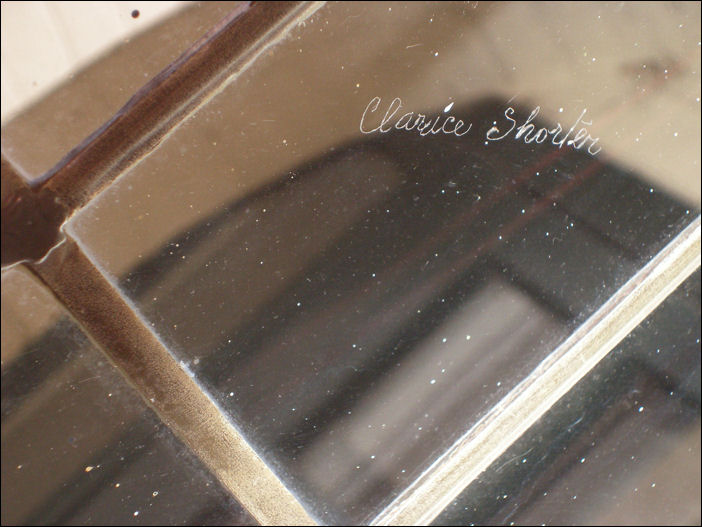
‘Clarice Shorter’ – a name that links iconic ceramic imagery to a clandestine love
affair between Clarice Cliff and Colley Shorter
“I suppose the giveaway is the signature,” says John as he guides me to the leaded mullion kitchen windows. “And there it is.”
He points, and I find myself unable to stop my hand reaching to the crude etching in the glass that roughen the whorls of my fingertips as they trace the amusing autograph – ‘Clarice Shorter’, it reads – a name that links iconic ceramic imagery to a clandestine love affair.
I’ve come to Chetwynd in Clayton because of Clarice Cliff; Clarice Cliff, the great pottery designer of ‘Jazz’ and art-deco; but I quickly realise that this house now very much belongs to someone else.
“Naturally,” explains Flavia, “I’ve tried to preserve and return the specifications to how Clarice and her husband Colley Shorter would have remembered it, but only because they, and they alone, particularly Clarice would have known its true condition.
And even though we get tourists visiting throughout the year, coming just to see where Clarice Cliff once lived and died, the most important thing about Chetwynd for me as the present owner is its architecture.”
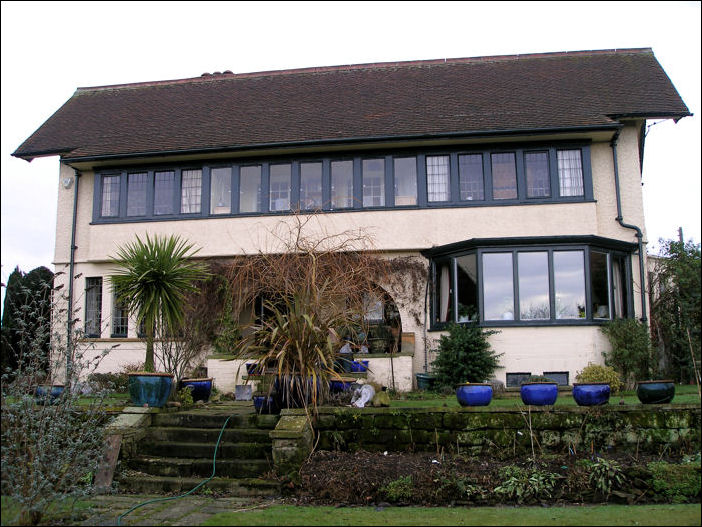
Chetwynd House, Clayton -
former home of Clarice Cliff and her husband Colley Shorter
Professor Swann is Dean of the School of Arts, Design, Media and Culture at the University of Sunderland. It is here that she met John who is currently studying for a master’s history degree.
“If people come looking for ghosts,” John advises, “I’m sure they won’t find any now. But strangely I’ve been aware lately of a strong smell of pipe tobacco in the gardens. Of course Clarice loved the garden as Flavia and I do very much. Did you know that Clarice was said to have smoked a pipe? I can smell pipe tobacco, but I’m sure there’s no connection.” He grins mischievously as Flavia begins to fill in the architectural background.
“The house was built in 1899 by Parker and Unwin, famous for developing town planning architecture in the Arts and Crafts style. It was built for the Goodfellow pottery family and later of the Vine Pottery.
Colley Shorter bought the house in 1926 and moved his wife and family here bringing with him the name of his former Wolstanton house named by his father, Chetwynd. In those days the house high in the countryside would have had the benefit of unimpeded views over the whole district.
Parker and Unwin produced a house for the commissioner, Charles Frederick Goodfellow, and it was called Goodfellow House. It was built with a sloping roof on all sides to make sure that light should always flood into every space bringing brightness and airiness and therefore cheeriness directly to the heart of the house.
Parker and Unwin actually designed a proposed Clayton Garden Village on the site but it didn’t materialise. Such was a magnificent concept that they moved further into the East Midlands where they built the famous Letchworth Garden City.”

Flavia and John give me the grand tour starting with the kitchen looking out onto a cobblestone courtyard now hiding the original servants’ quarters and used as annexes mainly for storage. The ground-breaking Arts and Crafts designated use of decorative space is of truly awe-inspiring, though modest proportions seemingly controlled from a glass-panelled aisle above a central lobby area and provides access to individual bedrooms.
“The architects even took the servants into the equation in providing space for them to move around the house without actually interfering with the residents,” points out Flavia following the corridors that run parallel to the main passages.
The main entrance is on the south-west side where a typical Arts and Crafts timbered porch conceals an oak door with a leaded glass window panel portraying a rural landscape, and this opens into an ample reception area.
“This room was originally built as an open central courtyard within the body of the house,” explains Flavia, “But it was re-designed by Clarice and she made it into a second living room. Nevertheless it does not impede the design specifics which were intended to promote a feeling of social space and to provide sunlight throughout the day with windows set to view the world all round at 360 degrees.”
To the right of the entrance passing a formal dining room containing a window seat is the main living room which is utterly sensational. On one wall there’s a wide unchallenging inglenook containing an original triptych painted by Colley Shorter’s chief Wilkinson’s designer John Butler depicting an Arthurian landscape with armour-clad knights astride rearing white stallions. To the right a purpose-built naturally-lit triangular recess snugly encompasses a grand piano poised to play, waiting with annotated sonatas placed open on the music stand. But it is the views from this room that reach over the impeccable and cherished garden that underscores this stunning location. I do not so much envy Flavia and John – I am shamefully covetous of their wonderful home. In its purity it is Staffordshire’s best in Arts and Craft. It hints of Clarice, but it isn’t Clarice Cliff.
“I came to the Potteries in 1976 to teach at the polytechnic; and with a growing family we all set about looking for a big house, a family home that would fit us all in,” recalls Flavia. “By chance we were driving along the road outside, Northwood Lane from Trentham to Clayton, when my daughter Jane cried out, ‘Look there’s a sign saying big house for sale.’ We stopped and looked around noticing that much of the inside had been converted into office accommodation.
Even so, the original Arts and Crafts design could not be extinguished.
The house came up for sale at an auction and we won the bidding – we won this beautiful house. Since moving in we’ve spent most of the time restoring the house to its original form. It didn’t seem to matter that Clarice Cliff once owned it because at that time she had nowhere near the iconic status that she has now. Her designs have become seriously collectable since the late 1979s and naturally her tenure at Chetwynd House is an added bonus to its value.”
Flavia and John’s kitchen was used by Clarice Cliff as an office. It was here on October 23 1972 that Clarice’s long-time domestic helper and gardener, Reg Lamb, found her dead from a sudden heart attack.
Over the past 30 years much has been written about Clarice Cliff mostly centred on the innovation of her designs and some on her relationship with her boss Colley Shorter with whom she had an enduring adulterous relationship until they married soon after his wife, Ann, died in 1940.
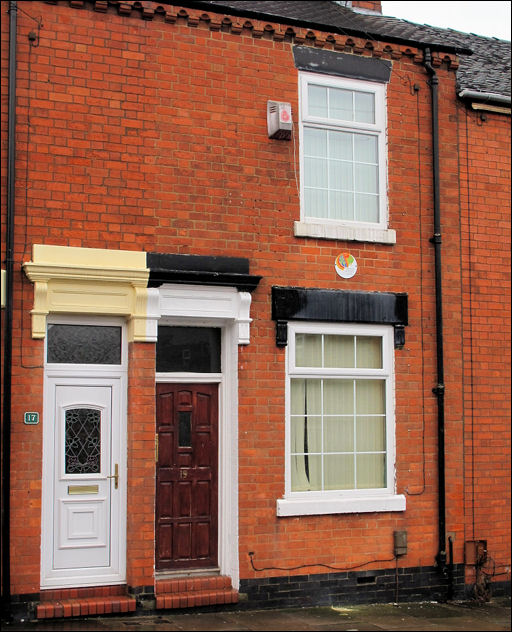
Clarice Cliff was
in born 1899 at 19 Meir Street, Tunstall
she lived here untill 1906
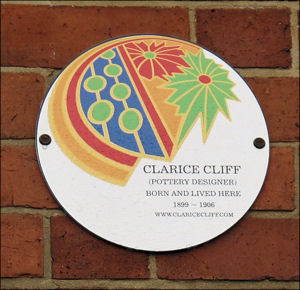
Clarice Cliff
Pottery Designer

|
Meir
Street
(High Street North)
Nixon, A. G., compositor
Collis, Jos. H.. estate agent. Greengates House
1
Beswick, James, blacksmith
3 Jones, J. E., cratemaker
5
Walker, W., potter's presser
7
Walker, Thomas, joiner
9
Hamlett, Sarah, widow
11
Bailey, W., railway booking clerk
—Here
is Greengates Street—
13
Cooper, Thos.. ridgemaker
15
Stockton, Richd., coachman
17
Jones, Charles, engine man
19
Cliff, H. T., ironmoulder
21
Broad, S., sen., insurance agent
23
Bereton, R., teapot maker
25
Hopwood, Sarah, widow
27
Broad, Sarah
29
Daley. Charles, potter
31
Kay, Thos., schoolmaster
2
Wilshaw, George, pointsman (N.S.R.)
—Here
is Greengates Street—
—Here
is Edwardes Street— |
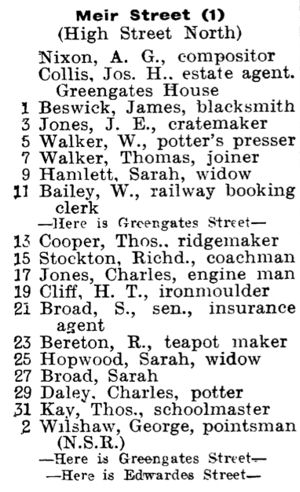 |
Clarice
was born at number 19 Meir Street, Tunstall in 1899
Her parents were Harry Thomas Cliff (ironmoulder) and Ann neé Machine
from..... 1907
Staffordshire Sentinel 'Business Reference Guide to The
Potteries, Newcastle & District'
Terry Abbotts is a Clarice Cliff devotee. A former pottery painter and art teacher for Royal Doulton, Terry and his friend, the late Dave Wallett, have diligently followed the Cliff story interviewing those who knew her and filming the places where she worked and lived.
“And this is where the story begins,” says Terry as we stand before a terraced house at 19 Meir Street Tunstall.
“Clarice was born here in 1899,” he continues, “into a large family of 8 children. As most did then at the age of thirteen she went to work as a lithographer at the local potbank. It’s not known how good an artist she was but one of her contemporaries told me in interview that Clarice was ‘rather good with a brush.’
When she was 17 Clarice started to work for Wilkinson’s in Middleport and after three years she was apprenticed to the eminent artist John Butler as a modeller. That’s when she became linked with the owner Colley Shorter who was influential in launching her celebrated career.”
The mid-terrace house where Clarice Cliff was born is today owned by Shahmin Aktar and his family. Terry ran through the Clarice Cliff story for him in the pleasant living room looking out on a narrow backyard; but a nonetheless cordial Mr Aktar failed to take in what the fuss was about, but was pleased to make us a cup of tea while Terry rambled on.
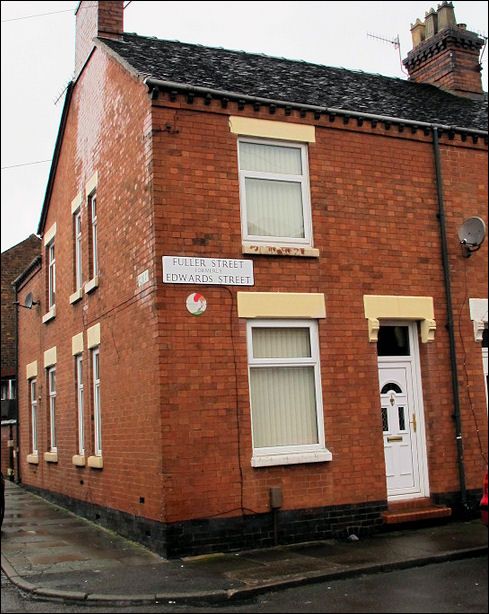
No 1 Edwardes Street,
Tunstall - where Clarice
Cliff lived for 38 years
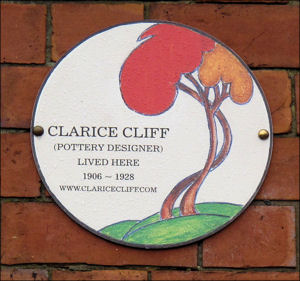
Clarice
Cliff lived here 1906 - 1928
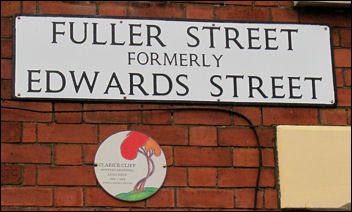
Edwardes Street was
renamed Fuller Street in the mid 1950's
(note that the sign misspells Edwardes as Edwards)
Just around the corner is the end red-brick house in Fuller Street where Clarice lived for
30 years. The Zarda family has been resident here for 7 years. Sixteen year old Anzeelia is a pupil at nearby Brownhills High School. Yes, she says, “I know a lot about the famous previous owner. It was my teacher who told both me and my brother that a famous pottery artist once lived here,” Anzeelia grins charmingly. “I don’t know why she was famous, but I certainly intend to find out.”
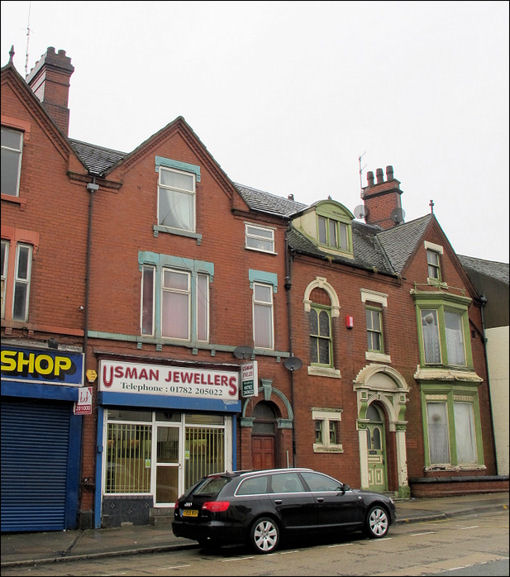
the flat at 20 Snow Hill that Clarice occupied from 1936 until she married Colley Shorter in 1940
Later Terry and I travel to Snow Hill, Shelton, a suburb of Hanley the centre of the Potteries. Terry points to a window over the shuttered shop of Ghazni, Indian jewellers.
“This is the flat at 20 Snow Hill that Clarice occupied from 1936 until she married Colley Shorter in 1940 when his wife died. It was a place she was comfortable with, a place where she could entertain friends and be independent,” explains Terry.
But the principal visitor to the Snow Hill flat, according to Clarice Cliff’s most recent biographer, Lynn Knight, was Colley Shorter and their affair was observed with much eyebrow-raising; although, Ms Knight writes, the relationship was “widely known within the industry by this time”.
Ensconced at Chetwynd – the new mistress of Chetwynd House – Clarice provided the house with her metaphorical signature – it was her home, her soul, a home where she joyously tended her own five acre garden in which, like her famous pottery, she filled with bold design and colour.
Clarice Cliff’s renowned Newport Pottery is long gone and retracing her footsteps has become pointless as new houses stand here now. Her name naturally lives in ceramic art but for me, perhaps the touching signature etched in the mullioned window at Flavia Swann’s Chetwynd says most about whom the great designer really wanted to be – and that is, Mrs Clarice Shorter, wife of a pottery owner.
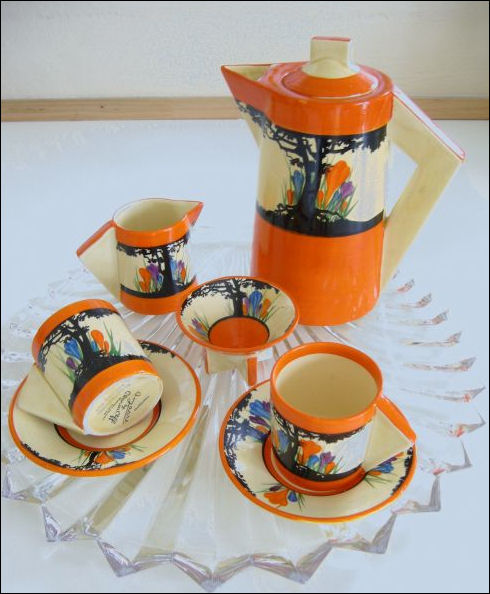
Clarice Cliff - classic
art deco tea set
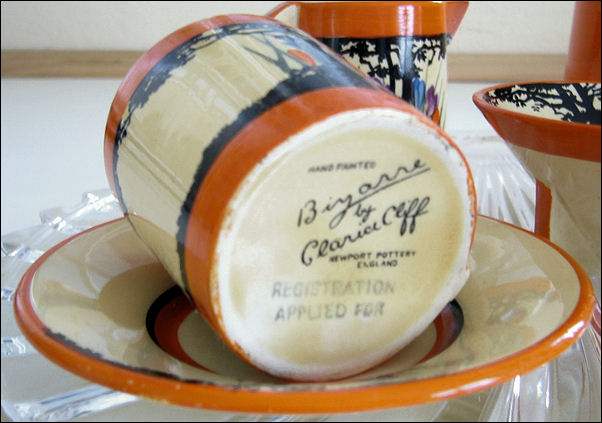
Bizarre by Clarice Cliff
- Newport Pottery
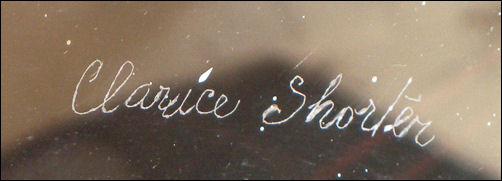
Clarice Shorter
signature
Fred Hughes

|
![]()
![]()
![]()